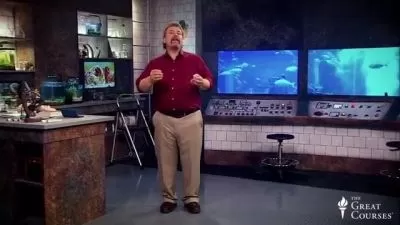National Geographic Polar Explorations
Michael E. Wysession
11:09:47
Description
Enchanting and otherworldly in their beauty, the polar regions are some of the most isolated and least understood places on Earth. Until relatively recently, few non-indigenous people had experienced their immense majesty. And yet, while remote, these extreme environments are endlessly fascinating, and eminently worthy of witnessing firsthand, especially if you are prepared to understand what you are seeing.
Now, Polar Explorations, a one-of-a-kind educational journey created in collaboration with National Geographic, provides you a 360-degree view of the Arctic and Antarctica in 22 visually stunning lectures plus bonus video: Unforgettable Moments from National Geographic's Polar Trips. A travelogue, science class, and history lesson rolled into one comprehensive course, Polar Explorations provides you with the context necessary to fully appreciate the splendor of the poles, including insights into:
- geology,
- astronomy,
- zoology,
- oceanography,
- history,
- culture, and
- photographing unique subjects.
Whether you’ve always dreamed of an expedition to these incredible ice-bound worlds or you’re simply curious about the wonders they hold, this course transports you to some of the most intriguing and alien places on the planet. Through powerful, rare images and extensive video, these lectures offer you a captivating, in-depth look at what makes these places so exceptional and why they beg to be studied. This spectacular footage, shot on location during voyages with National Geographic Expeditions—the travel program of the National Geographic Society—provides you with an immersive experience unmatched by anything short of actually journeying to the ends of the Earth.
Take this opportunity to venture to the polar regions and you’ll witness breathtaking sights unparalleled on our planet, including:
- Antarctic ice sheets covering an area one-and-a-half times the size of the United States and up to three miles deep (representing 90% of the world’s ice and 70% of its fresh water);
- magnificent blue icebergs and massive calving glaciers;
- periods when the sun and the moon are continuously visible and never set;
- astonishing seabirds, from penguins and puffins to skuas and petrels;
- bizarre sea-based life-forms such as diatoms and sea butterflies; and
- other remarkable wildlife in action, including polar bears, Arctic foxes, walruses, narwhals, seals, and orcas (also known as killer whales).
An Educational Adventure Led by Five Noted Authorities
Not only does this unforgettable educational journey feature spectacular National Geographic footage but also it presents a multidisciplinary team of renowned instructors hand-picked by National Geographic and The Great Courses, who share their expert insights on these ever-changing places.
You’ll begin with Pulitzer-Prize nominated journalist and National Geographic magazine contributing writer Fen Montaigne on the question of why people journey to the poles—from intrepid 19th-century explorers like Ernest Shackleton to today’s leading scientists—and discover an answer more complicated than you might imagine.
Directing your attention skyward to explore the regions’ unique relationship with the heavens is Edward Murphy, Associate Professor of Astronomy at the University of Virginia. Adopting an astronomer’s-eye view of the poles, you’ll investigate:
- why the sun behaves differently at the North Pole, rising and setting only once each year;
- how Antarctica has changed throughout history, with evidence showing it was once a jungle-covered landscape;
- why Antarctica is the world’s best place to conduct certain kinds of astronomical research;
- what causes seasons and how they’re experienced at the poles; and
- spectacular auroras and other unique polar phenomena.
Next, Michael Wysession, Associate Professor of Earth and Planetary Sciences at Washington University in St. Louis, reveals the fascinating geology and geography of the poles, from how they were formed to how they continue to evolve. You’ll come to understand the differences between the Arctic and Antarctic environments—the former a vast frozen ocean surrounded by diverse landscapes, the latter an icy desert continent—as well as their many similarities. Professor Wysession also illuminates how conditions in each location drive the global conveyor belt of ocean currents and winds that heat and cool the earth.
Surviving in a Frigid World
In addition to the marvelous footage of ice, snow, and ocean you’ll witness in these lectures, Polar Explorations shines a spotlight on the many amazing forms of life that call the polar regions home. Some of the wildlife you encounter will be familiar, such as the polar bears of the Arctic and Antarctica’s many penguin species. Others may be somewhat foreign, from the microscopic creatures that live beneath the surface of the sea ice to the amazing Arctic tern—a bird that makes pole-to-pole migrations of 40,000 miles a year or more. You’ll also take a deep dive into marine ecosystems with National Geographic Explorer-in-Residence and marine conservationist Sylvia Earle, who explains the central importance of sea ice to virtually every living thing in polar waters—from the tiniest phytoplankton to the largest whales.
You’ll come to understand the interdependence these creatures have with each other—and with the ice—in these delicate ecosystems, as well as the history of human-wildlife interactions. Particularly eye-opening are lectures on the native peoples of the Arctic, including the Inuit of North America and Sami of Eurasia, who have made their home in Alaska, Canada, Greenland, Russia, and the Nordic countries for millennia. Equally thought-provoking are the findings in zoology, oceanography, physics, and climatology emerging from research stations at both poles. This research, as you’ll discover through riveting stories of triumph and tragedy, wouldn’t be possible without the efforts of American and European explorers of the 19th and 20th centuries who risked their lives to map the unknown reaches of both poles, opening these frontiers to science.
A Photographer’s Dream Come to Life
For those who plan to visit the polar regions, learning how to take compelling photographs in these unusual environments will aid in capturing memories of the abundant wildlife and stunning panoramas. For this reason, the course concludes with a pair of lessons on polar photography presented by Ralph Lee Hopkins, the founder and director of the onboard photography program for the National Geographic-Lindblad Expeditions fleet. These lectures provide special insight into the unique opportunities and unexpected trials of photography at the ends of the earth.
Hopkins, who has two decades of Antarctic and Arctic experience, addresses not only the basics of preparation and gear, but also offers advice on overcoming the creative challenges of shooting at the poles, such as white-on-white vistas and animals in action. With these expert tips and tricks added to your repertoire, you’ll find yourself better prepared to take stunning photographs that capture the true majesty of these frozen worlds.
Journey to Awe-Inspiring Environments
Our unique partnership with National Geographic affords us the rare opportunity to bring lifelong learners and prospective travelers a truly cross-disciplinary lecture series that taps into the life experiences and expertise of top professionals and professors in their fields. The course is lavishly illustrated with rare and unique footage from National Geographic trips and scientific explorations, custom-made animations, and historical photos and film. Maps, charts, diagrams, and studio demonstrations are also employed throughout these lessons to enhance your comprehension.
Polar Explorations is a veritable feast for the eyes, but this comprehensive course does so much more than showcase the beauty of these remarkable locales. It gives you the scientific and cultural context necessary to understand their unique nature and irreplaceable value—not only to the people and wildlife that inhabit them, but to all humanity.
More details
User Reviews
Rating
Michael E. Wysession
Instructor's Courses
The Great Courses
View courses The Great Courses- language english
- Training sessions 22
- duration 11:09:47
- English subtitles has
- Release Date 2023/06/06









